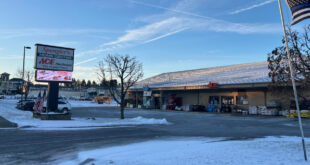Amazon and Walmart, two of the country’s largest retailers, are taking drastically different approaches to choosing locations for their corporate headquarters, The New York Times reports.
Doug McMillon, Walmart’s chief executive, sent a letter to employees earlier this month, announcing the company’s decision to stay in Bentonville, Arkansas. The New York Times reports that the retailer will replace its aging headquarters, a constellation of approximately 20 buildings scattered across several communities, with updated office space.
Walmart’s new corporate headquarters will cover roughly 350 acres and facilitate a “digitally native workforce.” Construction of the new headquarters will take place over the next five to seven years, according to The Times’ report.
“You’ll see improved parking, meal services, fitness, and natural light—yes, natural light,” McMillon writes in the memo.
Walmart’s current Bentonville headquarters was built in 1971 by the company’s founder, Sam Walton. Walmart has 1.5 million employees and is the largest private employer in the nation. The new headquarters is expected to be home to approximately 17,000 employees, according to The Times.
In contrast, Amazon’s recent announcement to build a second headquarters somewhere in the U.S. or Canada has launched a bidding war among major metropolitan cities, The New York Times reports in a separate article.
Amazon, which is now the largest corporate employer in its hometown of Seattle and occupies nearly one-fifth of the office space in the city, has specified what would be required from its new headquarters, which it is currently calling HQ2, the Times reports. The second headquarters would house approximately 50,000 employees, according to the article.
The company seeks a “metropolitan area with more than one million residents … on-site access to mass transit, a commute of 45 minutes or less to an international airport and easy access to a major highway or arterial road—no more than two miles,” according to the Times.
The newspaper reports that the company also emphasized the importance of a diverse population and plenty of recreational opportunities for Amazon employees, in addition to requesting traffic congestion information, lists of nearby universities and maps that show cellular phone signal strength from each prospective city.
Amazon is also seeking financial incentives from prospective cities, adding that its new headquarters should be located in a “stable and business-friendly environment” and that “special incentive legislation” may be required to land HQ2, according to article.
The online retailer received public subsidies to expand its network of warehouses. According to The Institute for Local Self-Reliance, a nonpartisan research and advocacy group, Amazon received $613 million for 40 warehouses built between 2005 and 2014.
“Cities and states have a wide array of tools for giving corporations tax incentives and subsidies,” Stacy Mitchell, co-director of the institute, says. “So the notion that Amazon is imagining a deal of such magnitude that it would require special legislation is pretty brazen.”
The New York Times describes a possible “winner’s curse” for the city that ends up home to HQ2. Currently, approximately 10 percent of Amazon’s employees work in Seattle, a city that has seen increased traffic, skyrocketing real estate prices and fierce competition for technology talent.
Ed Lazowska, computer science professor at the University of Washington, says HQ2 would provide another city with the chance to become a significant hub for technology and commerce.
“I think there’s no way to accommodate another 50,000 engineers and executives in Seattle,” he says. “I also don’t think it would be healthy for Seattle to have that. As much as I love Amazon, to have that great a density of a single company, it means you’re a one-horse town.”
Numerous American cities are vying to be home to Amazon’s second headquarters, some of which are using unique methods, according to The New York Times.
Southwest Corridor, an economic development group representing Arizona, sent a 21-foot-tall Saguaro cactus to Amazon’s Seattle headquarters. Muriel Bowser, mayor of Washington, D.C., uploaded a video advertising the benefits of her city and included shots of an Amazon Echo and a copy of The Washington Post, a newspaper owned by Jeff Bezos, Amazon’s founder.
 Hardware Retailing The Industry's Source for Insights and Information
Hardware Retailing The Industry's Source for Insights and Information






